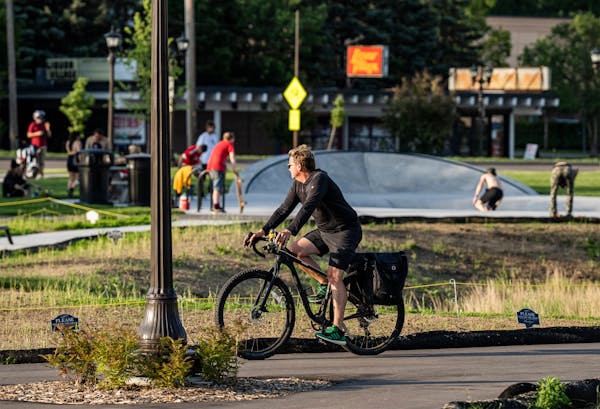A flock of geese, its leader honking loudly, flew low over the winding stream. Nearby, dogs and their owners romped in the new dog park. About 50 yards away, a group of children marched down bedrock stairs to where the stream flowed toward Hidden Falls.
A beginning-of-fall day at a regional park? A nature preserve?
Nope. It's the former site of the Ford Motor Co.'s Twin Cities Assembly Plant, and the new stormwater collection system running through the 122-acre site is not only drawing praise but has transformed a once-flat industrial tract into St. Paul's most talked-about development.
"We knew it was going to be special, but it's bigger and more transformational than I had imagined," said St. Paul City Council Member Chris Tolbert, who represents the area. "It has been and will be a place to visit for people who live in and visit St. Paul, and a great example of using stormwater as an amenity."
Bob Fossum of the Capitol Region Watershed District stood Wednesday on a bridge that crosses over the stormwater collection system — a feature, designed to look and act like a natural stream, for which his organization has spent decades advocating.
"We really wanted to seize this opportunity. This is a generational development," Fossum said. "We do projects, plan them, design them, implement them ... this is the first project of my career where this looks better than what I imagined."
The blocks-long stormwater collection stream running through the site — from a couple of blocks south of Ford Parkway past a newly extended Montreal Avenue on its way to the Mississippi River — looks recreational. But it has an engineering purpose.
Prior to redevelopment, polluted stormwater from the Ford site would travel to the river through an underground pipe without any treatment. When the site is fully developed, its stormwater systems will capture and clean 64 million gallons of water annually, preventing an estimated 28 tons of total suspended solids and 147 pounds of phosphorus from entering the river each year, according to the watershed district.
"The goal was to bring water back to this site," Fossum said. "The second thing was to treat it as a resource and not treat it as a waste product. There are environmental benefits, as well as social benefits, from connecting people to water."
As more of the site, now called Highland Bridge, is developed and commercial and residential buildings go up, each will connect to the stormwater system. Several giant underground tanks will collect rainwater, letting solids settle and filtering out chemicals, before releasing the water in a steady flow to the 4- to 5-foot-deep stream.
All along the length of the stream, there are places where people can walk or roll down to the water's edge. Ducks have already found the water to their liking, as have kayakers. In the winter, officials expect ice skaters to take advantage of it as well.
The city has approved tax-increment financing — which captures tax revenue from increased property values — to help pay for affordable housing as well as streets, parks and utilities at Highland Bridge. The city in 2016 projected it would contribute up to $275 million in public financing to the development.
But the water feature is not part of that financing. Developers will pay for it through connection fees as new housing and commercial space is built, said Tony Barranco, president of the North Region for Ryan Cos., the site's Minneapolis-based master developer.
Barranco, who was part of the Ryan team that spent months holding community meetings to address everything from building design to the grid layout of the site's 40 planned city blocks, said the water feature's size and scale exceeded expectations.
"It's fantastic. We knew it would be the marquee public feature in the project," he said. "But now that it's built, we said, 'Holy buckets, this is unbelievable.' "
The stormwater stream is bringing visitors to the site years before Highland Bridge's four new city parks and 3,800 housing units — including affordable apartments and significantly more expensive rowhouses and single-family homes — are complete.
"The most exciting thing for us is seeing the kayakers and seeing people sitting on the stones and dipping their feet in the water," Barranco said. "We didn't anticipate all of it, but all of it makes us happy."

How Minnesota House Republicans ended the DFL's state government trifecta
Project 2025 platform proposal aims to allow mining in Boundary Waters watershed

Ann Johnson Stewart wins special election, giving DFL control of Minnesota Senate

Democratic U.S. Sen. Amy Klobuchar defeats GOP challenger Royce White

